Protective elements – CZK 500
| 100 CZK | 200 CZK | 1000 CZK | 2000 CZK | 5000 CZK |

A detailed general description of protective elements visible in daylight, with illustrative examples of individual elements on the 2009 version of the CZK 500 note. The 1995 and 1997 versions of the CZK 500 banknote differ in the watermark, the windowed thread with microtext and the front-to-back register, and do not have colour-shifting ink.
- Watermark
- Windowed thread with microtext
- Coloured fibres
- Front-to-back register
- Latent image
- Colour-shifting ink
- Iridescent strip - the banknote does not contain this protective element
- Microtext
1. Watermark
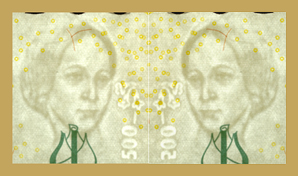
face side reverse side
The watermark is clearly visible when the banknote is held against the light. A “localised” stepped watermark (i.e. a combination of positive watermarks – visible as dark areas – and negative watermarks – visible as light areas – with various shades between the darkest and lightest parts) is used. The watermark is located in the middle of the wide unprinted margin and consists of the portrait of Božena Němcová as depicted on the banknote, a negative (white line) 500 and a primrose flower. When viewed from the face side of the banknote, the watermark portrait is mirror reversed.
2.Windowed thread with microtext
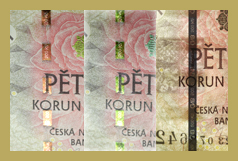
face side through-view
The windowed thread is a strip of metallic plastic, 3 mm wide, embedded into the paper of the banknote. On the banknote's face side it protrudes in five places from the surface. When the banknote is viewed, only the protruding part of the strip on the face side is visible. When viewed against the light, the whole strip is visible on both sides as a continuous dark line with the recurring hatched negative microtext “ČNB 500 Kč” showing through. The protruding parts change their metallic colour from puce to green when tilted.
3. Coloured fibres
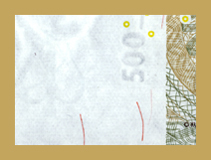
Orange fibres, 6 mm long, embedded in the paper and visible to the naked eye. They can best be seen on the white unprinted margins of the banknote.
4. Front-to-back register
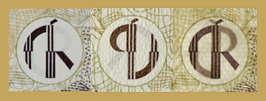
face side reverse side through-view
On each side of the banknote only a portion of this mark is visible. The complete mark, with precisely matching individual lines, is visible when the banknote is viewed against the light. The front-to-back register is a circular mark created by the letters “ČR”.
5. Latent image
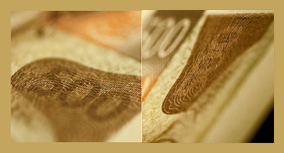
The latent image becomes visible only when the banknote is tipped horizontally at eye level and held against a light source. It consists of figures indicating the banknote’s denomination. When the banknote is looked at transversally (the long side nearer the eyes), a positive (dark) pattern is visible, and when viewed longitudinally (the short side nearer the eyes), a negative (light) pattern is visible. The latent image is located on the banknote’s face side in the decoration above the portrait’s shoulder.
6. Colour-shifting ink
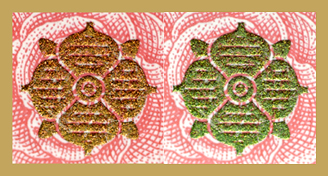
This protective element is based on an optical effect. The colour of the stylised flower printed with special ink changes depending on the position of the banknote when held against incidental light. The colour normally visible on the face side of the note changes colour from gold to green when the note is tipped against the light.
7. Iridescent strip
The banknote does not contain this protective element.
8. Microtext
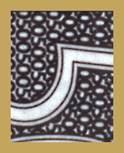
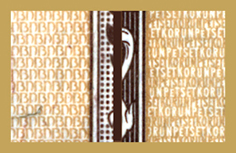
face side reverse side
Printed in offset printing. The basic microtext is concealed in the strip of basic colour near the right-hand white margin to the right of the portrait on the face side, consisting of figures indicating the banknote’s denomination. On the reverse side, microtext is also concealed in the strip of basic colour between the state symbol and the right-hand margin, consisting of words indicating the banknote’s denomination. The microtext initials of the writer (“BN”) are located in the field between the state symbol and the portrait.